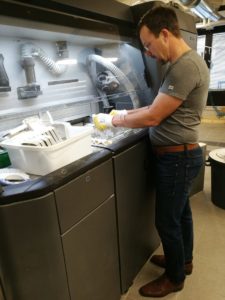Only a few people know that in southern Finland the ecosystem of companies and experts in the field of additive manufacturing or more familiarly 3D printing is quite versatile in proportion to the size of the region. The ecosystem also collaborates, which can be the basis of totally new industrial solutions. Among others, the new solutions of metal printing and bioprinting serve as the trendsetters.
Additive manufacturing is becoming a great tool for the medical industry as it enables printing of unique fully customized pieces, yet at an affordable price. 3D printing technology can be used for both prototyping and production of medical instruments, surgical prototype models, as well as custom-made implants and prosthesis. Indeed, 3D printing can be used for various applications to create parts adapted to the needs or to the morphology of the patients but what if instead of inanimate objects, it could be possible to print living human body parts?
3D printing technology can be used for both prototyping and production of medical instruments, surgical prototype models, as well as custom-made implants and prosthesis.
It sounds like science fiction, but it may well become a reality in the near future. Obviously, bioprinting of tissues and organs can’t be performed with a traditional printer as 3D bioprinting is a complex process. However, if you replace the ink of your traditional desktop printer with cell-laden hydrogel bio-ink and paper with bio-paper made from ingredients such as collagen or gelatin and add a third dimension, the depth, to complement the movement in the horizontal and vertical dimensions? With these modifications, you will end up with a basic 3D bioprinter capable of dispensing living cells embedded in a supportive hydrogel matrix in a layer-by-layer fashion according to a CAD model. As the hacking of an inkjet printer is not as straightforward as it may sound and not everybody is keen to build a bioprinter of their own from the scratch, luckily nowadays there are several commercial bioprinting systems already available, as many new bioprinting companies have emerged during the past few years.
Turku-based 3DTech Ltd has launched on the market their modular Brinter™ bioprinting platform, which is the first ever bioprinter developed entirely in Finland. Modular bioprinters are cost-effective solutions offering several print heads based on different dispensing principles in a single printing platform. This allows the printing of various biomaterials with different viscosities into a single construct. The most common printing technology implemented in the majority of commercial 3D bioprinters is the extrusion-based approach due to its inexpensive assembly and operational costs. Extrusion-based printers dispense cylindrical filaments of bioinks employing either pneumatic (air pressure) or mechanical (piston) forces to deposit the bioink through a nozzle. Currently, bioprinters, such as Brinter™ can already be used in a variety of applications, such as a versatile tool for basic research in tissue engineering and regenerative medicine conducted at universities and research institutes.
The next new wave of personalized medicine will be 3D bioprinted customizable patient-specific drugs, which can be altered in terms of drug loading, the release rate, and the taste of medicine simply by changing the geometry of a tablet.
Moreover, before translating from bench to bedside, bioprinting offers a cost-effective solution for the pharmaceutical industry to shorten and enhance the productivity of the drug discovery process. Bioprinted tissue models (e.g. liver) with multiple cell types and a complex native-like physiological environment will eliminate the need to use test animals for testing drugs during the drug discovery process. In addition, bioprinting can be used to recapitulate the cancer microenvironment by precisely locating tumor cells and microcapillaries into a tumor tissue model to study cancer pathogenesis, growth, and metastasis.
The next new wave of personalized medicine will be 3D bioprinted customizable patient-specific drugs, which can be altered in terms of drug loading, the release rate, and the taste of medicine simply by changing the geometry of a tablet. Ultimately, in the long run, the bioprinting technology will provide inspiring solutions to address the shortage of organs for transplantation. As further progress is achieved in the field of biomaterials, bioprinting techniques, and cell technology, bioprinting will transit into clinical practice, as the printing of fully functioning tissues and organs becomes a reality.
The global market for 3D bioprinters has a value of approximately $774 million and is expected to grow at a compound annual growth rate (CAGR) of 18.8% between 2017 and 2025. Furthermore, it is estimated that by 2027 there will be over 5,000 3D bioprinting platforms installed worldwide, giving a unique opportunity to innovative 3D bioprinting rookies, such as 3DTech, to thrive and dislodge the current industry leaders. Undoubtedly, bioprinting will be the next trend in healthcare and personalized medicine.
Sanna Turunen,
D.Sc. (Tech.) in Biomedical Sciences and Engineering,
Product Manager,
3DTech Ltd,
Finland
Postdoctoral Researcher,
Tampere University,
Finland
Expert article 2523
Artikkeli on julkaistu alun perin Baltic Rim Economies -julkaisussa 29.5.2019. Pääset julkaisuun tästä.




 Näin lausahti pöydän toisella puolella istunut nuori tuotantoinsinööri, joka tutkiskeli kollegoineen tarkkaan tapaamiseen tuomiamme lämpimäisiä, nylonista HP:n Jet Fusion 3D-tulostimella tulostettuja mallikappaleita. Osat oli 3D-tulostettu asiakkaan pari päivää aiemmin lähettämiä step-tiedostoja hyödyntäen.
Näin lausahti pöydän toisella puolella istunut nuori tuotantoinsinööri, joka tutkiskeli kollegoineen tarkkaan tapaamiseen tuomiamme lämpimäisiä, nylonista HP:n Jet Fusion 3D-tulostimella tulostettuja mallikappaleita. Osat oli 3D-tulostettu asiakkaan pari päivää aiemmin lähettämiä step-tiedostoja hyödyntäen.